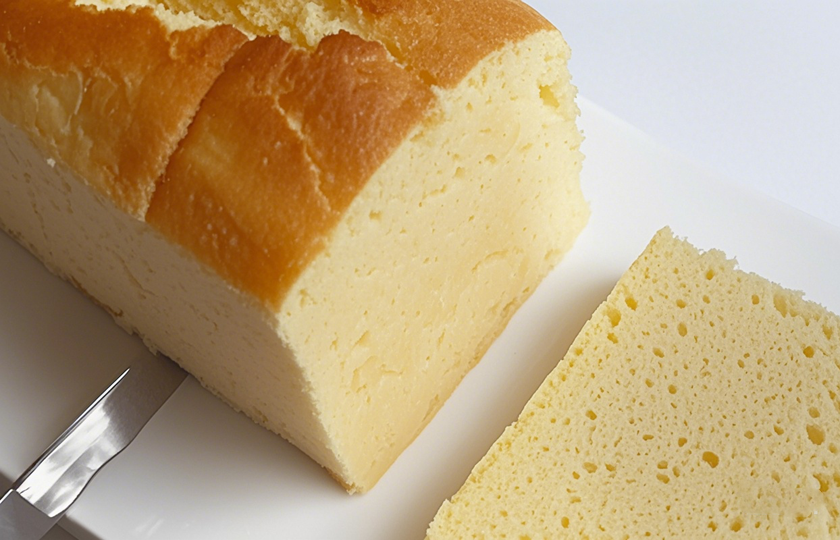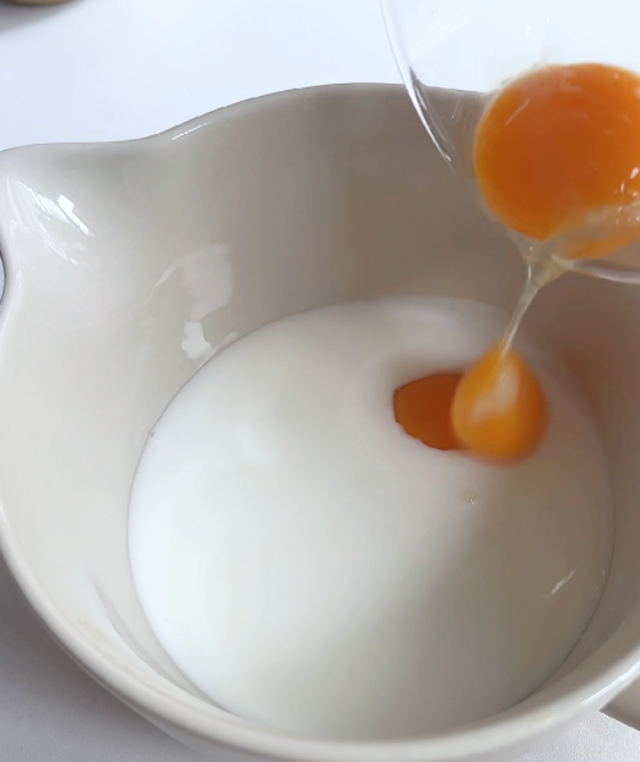Delicious & Lightweight: Low-calorie Yogurt Cake


Do you like desserts but are afraid of gaining weight? Don’t worry, I have discovered a magical low-calorie yogurt cake! It has a delicate taste and is extremely delicious, but it can perfectly maintain your figure. Today, let me take you into this sweet and healthy world!
Ingredients Needed and Substitutions
The ingredients you need to make the perfect low-calorie yogurt bread include:
Main ingredients:
Eggs: As the main source of protein for cakes, they provide structure and moistness to the cake.
Yogurt: Increases the moistness and taste of the cake, acts as a leavening agent, and makes the cake softer.
Low-gluten flour and corn starch : provide the main gluten and structure of the cake, making the cake softer.
Seasoning:
Sugar and lemon juice : provide sweetness and sourness , moisturizing and taste to the cake.
Alternatives:
Low-gluten flour : Can be replaced with ordinary flour or cake flour.
Corn starch : can be replaced with potato protein powder or starch.
Sugar : can be replaced with honey, brown sugar or sugar substitute.
Lemon juice : You can use other citrus juices or vinegar instead.
What does adding yogurt to cake mix do?
First of all, yogurt can make the cake more moist and dense. It's like adding a layer of natural moisturizer to the cake, making every bite soft and sticky.
Secondly, yogurt can add a unique sour taste. This sour taste balances the sweetness of the cake, making the taste richer and more layered without being too sweet.
Yogurt can also help the cake ferment better. The probiotics in it are like little helpers, making the cake more fluffy and soft.
Is yogurt cake low in calories?
The calories in yogurt cake are relatively low. Traditional cakes are made with a lot of oil and sugar, so the calories are naturally high. However, yogurt cake uses yogurt to replace some of the oil, and the calories in yogurt itself are lower than oil. In addition, yogurt can make the cake taste moist and dense.
However, if too much sugar or other high-calorie ingredients are added during the production process, the calories will also go up. So as long as we control the raw materials, such as using sugar substitutes and choosing low-fat yogurt, we can keep the yogurt cake low in calories.
What type of cake has the least calories?
The first is angel food cake. It is mainly made of egg whites, without egg yolks, and has a very low fat content. Without the fat and cholesterol in the egg yolks, the calories in angel food cake are reduced. It tastes very soft and light like a cloud.
There is also the low-calorie yogurt cake I just mentioned. Yogurt replaces a lot of fat, and if you use sugar substitutes and control the amount, its calories will be much lower than ordinary cakes. Yogurt keeps the cake moist and adds nutrition.
In addition, if you use less oil and sugar when making sponge cake, the calories can also be reduced. It mainly relies on the beaten eggs to support the fluffy structure of the cake, and the relatively simple ingredients also allow it to reduce calories. However, you must pay attention to strictly control the amount of oil and sugar added when making it.
Tips for Success
To make a perfect low-calorie yogurt cake, pay attention to the following points:
First, the eggs and yogurt should be mixed evenly to ensure the delicate taste of the cake. Remember to use a whisk or electric mixer to stir thoroughly until the egg liquid and yogurt are completely blended.
Secondly, sifting the flour and cornstarch is essential, which can remove lumps in the flour and make the cake softer.
Add the sugar in moderation and add the egg liquid in batches, stirring thoroughly each time. This way the sugar can dissolve better and the sweetness of the cake will be more even.
Lemon juice is added not only to enhance the flavor, but also to help the cake rise better, so don’t forget to add it!
Finally, the baking temperature and time are also critical. The cake should be baked slowly at low temperature to allow it to slowly become fluffy and colored. Only in this way will the cake be soft and have an attractive color.
INGREDIENTS
Main Ingredients
-
·3 eggs
-
·230g yogurt
-
·70g low-gluten flour
-
·15g corn starch
Seasonings
-
·40g sugar
-
·5ml lemon juice
COOKING STEP
Step 1
Mix 3 egg yolks and 230g yogurt evenly.

Step 2
Add 70g low-gluten flour and 15g corn starch and mix well.

Step 3
In another bowl, add 3 egg whites and 40 grams of sugar and beat until foamy.

Step 4
Mix the meringue and yogurt paste evenly and pour into the mold.

Step 5
Pour hot water into the baking tray and bake at 140 degrees for 55-60 minutes using the water bath method.

Step 6
After baking, let it cool and remove from the mold.

How to Store Low-Calorie Yogurt Cake
Refrigerate and seal: After making, it is recommended to store the cake in the refrigerator and make sure the cake is sealed to prevent the intrusion of air and moisture, so as to maintain the freshness and taste of the cake.
Eat as soon as possible: To maintain the best quality of the cake, it is recommended to be consumed within 3 days of making it.
Package and store: If the cake is large, you can cut it into small pieces and then package and seal them in fresh-keeping bags. This can more effectively control the shelf life of the cake and prevent it from spoiling.
Precautions
Avoid placing the cake near the refrigerator door or in areas with large temperature fluctuations to avoid affecting its quality.
If there is fruit decoration on the surface of the cake, it is recommended to wrap the fruit part separately to prevent the fruit from over-ripening or dehydrating and affecting the overall taste of the cake.
Serving Suggestions
Fresh fruits: Strawberries, blueberries, oranges, etc. are all excellent choices. The sweet and sour juicy strawberries, the slightly sour blueberries, and the refreshing oranges are paired with yogurt cakes, which not only enrich the taste but also add more vitamins. You can feel the freshness of the fruit and the density of the cake in every bite.
Low-fat cream: If you like a rich taste, you can add a small amount of low-fat cream. The delicate cream and the softness of the cake complement each other, and the slightly sweet feeling spreads in your mouth, giving you a full sense of happiness.
Tea drinks: Green tea, black tea or herbal tea are all very suitable for yogurt cake. The freshness of green tea can neutralize the sweetness of the cake and make the taste more refreshing; the mellowness of black tea can enhance the overall flavor; the unique aroma of herbal tea can bring a different taste experience.
Serving Suggestions
Temperature: After taking the yogurt cake out of the refrigerator, you can leave it at room temperature for a while before eating it, so that you can better feel the softness of the cake and the mellowness of the yogurt. If you like to eat it colder, you can eat the refrigerated cake directly, the taste will be firmer, like eating yogurt-flavored ice cream cake.
How to taste: Use a small fork to gently pick up a piece of cake, put it in your mouth, feel the dense texture of the cake first, then chew it slowly, so that the sourness and sweetness of the yogurt and the aroma of the cake can be fully released on the taste buds. If paired with fruit, you can chew it together with the fruit to experience the collision of different tastes and flavors. When paired with a drink, take a bite of cake and drink a sip of tea, and enjoy the wonderful taste journey brought by the combination of the two.
FAQs:
Another possible problem is the baking. If the oven temperature is too high, the surface of the cake will form a crust quickly, but the inside will not be cooked through. In this way, the liquid part inside will settle and become a pudding layer.
Solving this problem is not difficult. When mixing the batter, be sure to use a folding technique to gently and quickly mix the meringue and egg yolk paste. Also, when baking, don't set the temperature too high. 160-170℃ is quite suitable, so that the cake can be cooked slowly from the inside out, which can reduce the probability of the pudding layer appearing.
The second is that there is a problem with the baking time or temperature. If the baking time is not enough, the inside of the cake is not fully cooked, and it will shrink after it is taken out. Or the temperature is too high, the surface of the cake is crusted too early, and the inside is still expanding. When it is taken out, the temperature changes and it collapses.
The handling of the cake after it comes out of the oven is also very important. If the cake is not turned upside down in time to let the heat dissipate, the heat will form water vapor inside the cake, which will also cause the cake to collapse.
The solution is to pay attention to the state when whipping the meringue, and only wet foam with a small hook is good. When mixing the batter, the action should be quick and light, using the folding technique. When baking, bake at the appropriate temperature and time, such as 160-170℃ for 40-50 minutes, but it should be adjusted according to the temperament of your own oven. After taking it out of the oven, quickly shake the cake mold on the table, then turn it upside down on the drying rack, and wait until it is completely cool before demoulding, so as to reduce shrinkage and collapse.
The second reason may be that there is too much water in the batter. When the water is heated, it turns into steam and expands in volume, which will push the surface of the cake apart.
If you encounter cracks on the cake surface, there are a few tips to solve it. First, lower the oven temperature a little bit. I generally recommend around 160-170℃ so that the cake can be heated slowly and evenly. If you see that the cake has begun to crack, you can quickly cover the surface with a layer of tin foil to prevent the cracks from expanding further. In addition, when making the batter, you should also pay attention to the ratio of various ingredients and try to make the water ratio appropriate, so as to reduce the cracks on the cake surface.

















